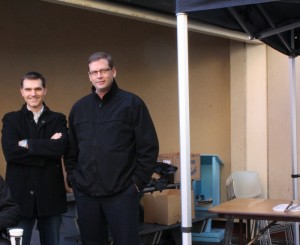Smokers at Camosun College’s Lansdowne campus may have to start bringing umbrellas for their smoke breaks in September. The current designated smoking shelter located outside the bottom of the Ewing building has been the cause of many complaints from students and staff.
The BC Health Ministry states that a smoking area must be at least three metres away from doorways, air intakes, and windows.
Camosun acting director of physical resources Ian Tol confirms that the shelter does meet the BC requirements, as long as those smoking are standing under the shelter’s covered area.
One of the options to help with the complaints regarding smoke entering the building would be to modify the shelter so that the side closest to the Ewing building entrance would be closed off. But that solution isn’t likely as it wouldn’t alleviate the smell of smoke in the building. The other options are to move the smoking shelter or get rid of it altogether.

“We may move the shelter right out; at that point do we have a perimeter smoking area or do we just go smoke-free?” says executive director of human resources Denis Powers.
Although the plan was initially to go smoke-free in fall 2012, there have been factors – such as people smoking out of designated areas, policy enforcement, and whether or not the time to go smoke-free is right – for the college to consider, which has slowed down the decision.
“There have been issues from the neighbourhood associations, particularly Argyle Avenue, who are concerned about us going smoke-free,” says Powers. “A lot of people just go into the parking lots or even in their car. It’s not ideal because then we get the problem of people coming back into the workplace with smoke on their clothes and that’s also an issue for us.”
Perimeters with park benches off campus would most likely be the choice in the event that Lansdowne does go smoke-free. Whatever the new policy is come September, it will require enforcement.
“You don’t really have people heavily enforcing it, so what’s the point of making a policy if you’re not going to have somebody actually follow up on that?” says psychology student Alannah Pearcy.
Research and discussions with other institutions has led the Tobacco Use Reduction Task Force (TURTF) to suggest active enforcement of the new policy. (TURTF is a Camosun sub-committee of the Joint Occupational Safety and Health Committee.)
“The TURTF has spoken to several other institutions about the importance of an enforcement policy with teeth, including warnings and fines for repeat offenders,” says the TURTF’s Tony Webster. “The current designated smoking area policy is merely socially enforced, with at best only partial success.”
According to Powers, a lot is done to encourage compliance to the current policy, which only allows smoking in the designated areas on campus. And while September may be too early to make the switch, Powers says if Camosun doesn’t go smoke-free then, it eventually will.
“It becomes second nature after a while,” says Powers. “You don’t smoke in a hospital, you don’t smoke in a mall; we want to get there with the college.”
